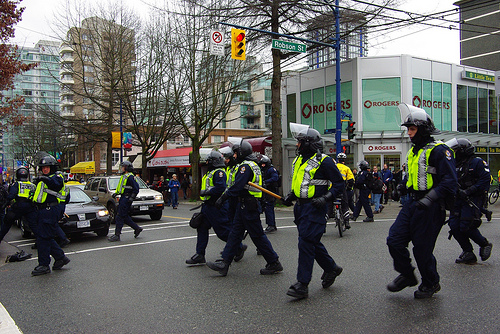By Joe Johnson (The Cascade) – Email
Print Edition: November 9, 2011
 It was the largest crime spree in the history of the province, according to Vancouver police chief Jim Chu. And now after five months of taking criticism over their handling of the riots, including complaints about the slow process afterwards, the Vancouver Police Department are now ready to begin moving forward.
It was the largest crime spree in the history of the province, according to Vancouver police chief Jim Chu. And now after five months of taking criticism over their handling of the riots, including complaints about the slow process afterwards, the Vancouver Police Department are now ready to begin moving forward.
The investigation up to this point has largely consisted of amassing a database with 30,000 pieces of evidence obtained from sources like Facebook and Youtube. It has also involved combing over 5,000 hours of video footage, posting photos on the VPD website, and utilizing new technology at the University of Indianapolis to pinpoint suspects.
The results of this work have now become the first set of recommendations to be forwarded to the Crown council where the evidence will be sorted through. It consists of charges against 60 alleged rioters over 163 separate acts. 50 of those to be charged are men and 10 women, and the group ranges in age from 16 to 52 years old. Some of these cases are over 500 pages each.
The greatest number of the charges come from Surrey (21), then Vancouver (12), Maple Ridge (9), Abbotsford (2), Delta (2), and the rest are distributed scattershot among other local municipalities. Of note is one person from Seattle, Washington.
With so much evidence, the police force must take their time to ensure that best practices are maintained, meaning it could take up to two full years to have all charges laid on up to 700 people. Chu defended the VPD’s actions in a news conference, stating: “Over the past few months there have been those who have told us that our decision to be thorough was wrong. They urged us to rush cases to court. We believe the public expects more from the police.”
Chu’s sentiments certainly ring true at UFV – the majority of students who spoke with The Cascade on the issue supported taking the time necessary. Don Ngo – a business and aviation student – offered, “It’s a little long compared to what other people are doing, [for example,] compared to the one in London where they laid charges pretty much right away. It’s long, but it takes time to investigate all of the actions of the people, I guess. It’s long but it’s thorough.” Kylie Lim, a fashion design student, differed in her take on the issue, saying, “ I don’t know how many people are on the case, but two years seems long… I mean, [long] if [someone’s] going to get arrested two years later for a little broken window.”
There was no sympathy for the rioters to be found on campus. Visual arts student Kate Feltren said, “I think that many people would agree that police should crack down on the rioters. I think it’s unfair to let it slide just for this particular case, and I think that lots of people need to be made an example of.” Alanah Jones – a fashion design student – agreed. ”I think it shouldn’t be taken lightly. That was so barbaric and embarrassing and testosterone-filled,” she said.
However, some question whether certain aspects of the investigation are worth the effort. Ian MacKenzie, a UFV criminology professor with over 30 years of experience on both the VPD and Abbotsford Police Department, spoke on the issues of effort and cost-effectiveness. For example, he explained, the VPD sought resources in Indianapolis for a cost of $300,000 to catch an additional eight suspects who may have been caught using traditional techniques here.
MacKenzie also discussed how most charges will be of break-and-enter and mischief, but given the circumstance, the laws concerning the different stages of the riot will also be levied. These are sections 63 and 64 of the Canadian Criminal Code: unlawful assembly and rioting. Unlawful assembly is defined as the gathering of three or more people with the purpose of causing fear for those in the vicinity, while advancing others to disturb the peace. Rioting, a serious offence, is “an unlawful assembly that has begun to disturb the peace tumultuously.”
MacKenzie noted that the sentencing of rioters may, in the end, be considered light by some, as “the judge must sentence based not only on the offence, but also on the particular circumstances of the specific offender.”
“General deterrence will be important,” he explained, “but it is not the only factor that will be considered. Assuming that many of the rioters are not actually criminals, don’t be surprised if they are not sentenced to jail but instead get fines, probation, etc.”
MacKenzie said he was interested to see how these events will work themselves out in court. “It is clear that there is political and public pressure to see some harsh sentences,” he said, “but judges are constrained by the law and sentencing guidelines, and I certainly would not be surprised if there is a dichotomy between public expectations and the sentences that are actually handed out.”


